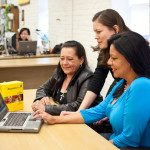
In 2008, after some members of the tribe began excavating Morris’ sources, the Chitimacha tribe partnered with Rosetta Stone to create computer software for learning the Chitimacha language. Today every registered member of the tribe has a copy of it, and a dictionary is in the works. The Chitimacha language is now used in classes and the Chitimacha reservation in Lousiana recently launched a preschool immersion program to educate the next generation of speakers. With 96% of the world speaking roughly 4% of known languages, reviving lost languages and providing resources and community for minority language speakers is empowering to both individual cultural identity and collective linguistic knowledge.
Image source: Daniel W Hieber; published on The Conversation; Members of the Chitimacha language team (from left to right) Sam Boutte, Kim Walden and Rachel Vilcan use the new language software for the first time.
#Chitimacha #nativelanguages #linguistics






